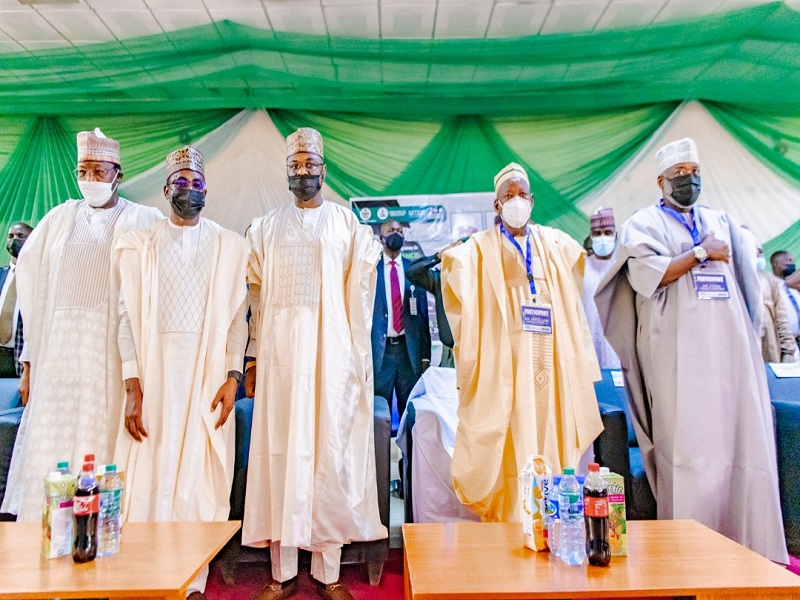Telecom
FG Trains Kano State Executives Council Members on e-Governance, Digital Transformation

The Federal Government has kick-started a pioneer programme to train Members of Kano Executive Council on e-Governance and Digital Transformation.

L-R: Prof. Umar Garba Danbatta, Executive Vice Chairman and Chief Executive Officer (EVC/CEO) of the Nigerian Communications Commission, Mallam Kashifu Inuwa Abdullahi, Director General, National Information Technology Development Agency (NITDA), Dr Isa Ali Ibrahim Pantami, Minister of Communications and Digital Economy, Dr Abdullahi Umar Ganduje, Governor of Kano State and a guest during the 2-day event in Kano recently.
This is in line with government’s plans to ensure the provision of enabling environment for the development of National Digital Economy Policy and Strategy (NDEPS), which is being driven by Ministry of Communications and Digital Economy, under the leadership of Minister, Dr Isa Ali Ibrahim Pantami.
The programme was initiated to give special training to the top government officials in the state on modern technology adoption, in order to improve their performances at all levels while delivering services to the general public.
The 2-day event commenced on Monday, 2nd August, 2021, and was attended by Kano State Governor, Dr Abdullahi Umar Ganduje, his Deputy, Dr Nasiru Yusuf Gawuna, Secretary to the State Government, Alhaji Usman Alhaji, Commissioners, and other members of the Executive Council of the state.
While making his address, Dr Ganduje thanked the Federal Government, particularly the ministry for bringing various initiatives, including training of over 1000 youths on digital skills and other supports provided in the state.
The governor commended Dr Pantami for matching words with action, adding that the e-governance training was as a result of his visit to the Communications and Digital Economy Complex in Abuja where he initiated talks on the possible collaboration and partnership with the Ministry to foster ICT development in Kano state.
He also hinted his government’s commitment towards the realization of ICT policy in the state. According to him, ICT has been a critical element to governance, and his administration is making all efforts to ensure that the state taps on the immense benefit of e-Governace and digital technologies by simplifying government operations as well as limiting government spending.
He said, “It is imperative we apply the new system being used anywhere in the world, because the old system of government would not move the state forward.”
The governor assured that he would continue to come up with ways to streamline government operations and reduce the cost of running his administration.
On his part, Dr Pantami, while delivering his keynote address, noted that the training is the first of its kind in Nigeria at the state level, and there cannot be a better place to start than Kano State, according to him, Kano State is the most populous state in Nigeria and the commercial nerve centre of Northern Nigeria.
He said, historically, the people of Kano have always been known to be hardworking and industrious. “They were among the first people to establish major industries and conglomerates in Nigeria, trading in food and drinks, textile and footwear, tanning, ceramics, and furniture,” he added.
Dr Pantami stated that the commencement of the programme makes Kano State Executive Council Members the first beneficiaries, which at the end, Kano will be well positioned to develop a strong digital economy, and have a transformational impact on the state and the nation at large.
He said that in light of global trends in the delivery of government services which is increasingly being characterized by the digitization of processes, the Federal Ministry of Communications and Digital Economy developed the Nigerian e-Government Master Plan (Ne-GMP) with the vision “to create a world class, open and digitized government that connects with people to drive efficiency in public administration, responsiveness of civil services and transparency in governance leading to improvement of the quality of life of Nigerians”.
“This is in line with the Ministry’s mandate to Utilize ICT to drive transparency in governance and improve the quality and cost effectiveness of public service delivery in Nigeria. The Plan was developed with specific strategies that will improve the quality of citizen’s lives by enhancing national competitiveness, facilitating market economy, promoting participatory democracy, and improving transparency in the public sector.
“These strategies include the expansion of the number of public sector personnel trained on e-Government and the publicizing of e-Government initiatives at the Federal and State Level. Various Capacity Building Programs have therefore been developed to aid the attainment of this goal,” he said.
Dr Pantami stated that the National Digital Economy Policy and Strategy (NDEPS) was developed and launched in 2019 to reposition the Nigerian Economy in order to take advantage of the many opportunities that digital technologies provide.
“This is in line with the vision of President Muhammadu Buhari to diversify the economy of Nigeria away from the dependence on the oil and gas sector, he said.
“As you may know, the NDEPS is anchored on eight (pillars, one of which is the Digital Literacy and Skills Pillar which provides policy backing for massive training of Nigerians from all works of life in order to enable them obtain digital literacy and other digital skills.
“An objective of the NDEPS is to support training and Capacity Building among public sector employees in the development and use of digital tools and applications to improve the delivery of government services.
“Furthermore, the Service Infrastructure Pillar provides support for Government Digital Services and the provision of robust digital platforms to drive the Digital Economy.
“This pillar supports the provision of a online platforms for government to interact with citizens and investors. It supports the deployment of government digital services and a paperless system. A key objective of the Service Infrastructure Pillar is the implementation of the e-Government Master Plan,” he added.
Dr Pantami also seized the opportunity to express his sincere appreciation to His Excellency, President Muhammadu Buhari, for providing the vision and leadership as well as his unwavering support, saying that “we could not have been able to achieve what the Ministry and its Parastatals achieved without Mr President’s continued support and we are most appreciative.”
Earlier in his opening remark, Mallam Kashifu Inuwa Abdullahi, director general, National Information Technology Development Agency (NITDA), said that the training programme is a milestone to the Kano State digital economy journey.
He emphasized that a lot can be achieved together, especially in e-governance and digital transformation which has five milestone; firstly, is about moving government services online for users to conveniently access government services as well as cost reduction, while the second one is to have open data for the state to engage its citizens, getting more information and data economy; and the third is using digital technology to inform decision easily by the data you have.
The DG added that, digital governance, which is fourth on the list, is beyond enhancing existing processes, he said it is about using technology as a source of inspiration to come up with new way of delivering services, using technology to come up with innovation in the way you do your business and unlock opportunities for the citizens.
He said the fifth one is to make the government smart by using emerging technology to predict what is going to happen, what the citizens are going to think and how to shape and equip the citizens’ mindset within the state.
“The programme is about how to design digital economy, position Kano State Government to key in to the Federal Government digital economy initiative, and this can be done through aligning three things: people, processes, and the technology. And this training is going to expose you, build your capacity to make governance easier,” he added.
Telecom
How Zabira is Empowering the Next Generation of Entrepreneurs

Financial independence is no longer a distant dream but a daily reality, especially for young entrepreneurs cashing out weekly through innovative platforms like Zabira.

From trading gift cards to paying bills with crypto-converted naira, Zabira is proving to be more than just a fintech app; it’s a complete digital marketplace designed to fuel the ambitions of the next generation of hustlers.
With users reportedly earning up to ₦150,000 weekly from ongoing campaigns, Zabira has become a go-to platform for side income and full-time digital entrepreneurship.
Its frequent cashback campaigns reward both new and existing users, allowing them to earn 2% cashback on their first crypto trade and 3% on their first gift card trade, a simple but powerful incentive that reduces entry barriers for young people stepping into digital finance.
But Zabira isn’t just about trading; it’s about everyday life. In a move to deepen its utility and promote seamless living, the platform has expanded its bill payment business unit. Users can now pay for airtime, data, electricity (PHCN), TV subscriptions, and even fund wallets for platforms like Bet9ja, all within the Zabira App.
Zabira allows users to make utility and other payments directly using crypto. For added flexibility, users can also instantly convert their crypto to naira, removing any limitations and ensuring seamless transactions without bank delays or downtime.
This subtle integration of crypto into daily transactions is a major leap forward in digital financial inclusion. It not only helps normalise the use of digital assets but also provides practical avenues for users to derive real-world value from their crypto holdings.
Zabira also understands the frustrations of online subscriptions, especially when traditional bank cards fail. Through its robust gift card marketplace, users can buy and use cards for platforms like Netflix, Spotify, Google Play, Apple, Amazon, and more.
These cards offer a reliable alternative for accessing services that are increasingly essential for both work and leisure and are especially helpful for digital creatives, remote workers, and students.
Beyond utility, the platform keeps the entrepreneurial spirit alive with bonus campaigns on first-time gift card trades, creating more reasons for users to engage and earn. With every trade, Zabira positions itself not just as a service provider but as a digital enabler supporting users on their financial journey.
In a country where access to financial tools can often feel like a privilege, Zabira is leveling the playing field. Whether you’re a student looking to subscribe to an online course, a freelancer paying for tools, or a small business owner funding your daily operations, Zabira is building the infrastructure that turns these goals into everyday wins.
To get started using Zabira, users can download the app on Android and iOS devices.
Telecom
Driving Digital Inclusion: Anambra’s Mobile Tech Hub Brings Free WiFi to the People

The Geeks & Founders Alliance for Soludo (GEFAS) has taken another bold step in supporting Governor Charles Chukwuma Soludo’s vision of a smart, connected Anambra with the official launch of its Mobile Tech Hub- a custom-built bus bringing free WiFi directly to the people.

Fully equipped with high-speed internet, voice and data services, and backup power, the GEFAS Mobile Tech Hub can connect up to 3,000 people at rallies, campaign grounds, and public spaces: expanding the Solution WiFi initiative already live at over 26 locations across Anambra.
The Deputy Governor of Anambra State, Dr. Onyekachukwu Ibezim, flagged off the Mobile Tech Hub at a brief ceremony held on Thursday, 24th July 2025, at the Tower of Light, Emeka Anyaoku Boulevard, Awka.
He was joined by the Secretary to the State Government, Prof. Solo Chukwulobelu; the Deputy Chief of Staff/Chief Protocol to the Governor, Chief Chinedu Nwoye; other senior government officials; the media; and the GEFAS community.
Dr. Ibezim, visibly excited as he inspected the hub’s features, described it as an initiative perfectly aligned with what the Governor is doing in the state.
“We don’t expect anything less from Agbata, who is a guru in this field: exactly why the Governor puts square pegs in square holes,” he said, pointing to the sophistication of the project and the Governor’s deliberate choices.
“I hear wherever this vehicle parks, people can connect freely, in line with our mantra of making Anambra a place to live, invest, work, relax, and enjoy
“I thank Agbata for this great feat and assure our government’s support to make Anambra the smart mega city we all desire
He further emphasized that this will not be a one-off.
“Mr. Governor is also working to make this permanent. We are not just going to leave you with one vehicle. So I encourage everyone: wherever you see this bus parked, connect to the free WiFi and get your job done.” he concluded.
Earlier in his remarks, Chukwuemeka Fred Agbata, CFA, GEFAS Convener and MD/CEO of the Anambra State ICT Agency, said:
“We are here to celebrate innovation made possible by Mr. Governor’s forward-thinking policies, like waiving Right of Way (RoW) charges, which opened up fibre optic expansion and connectivity across Anambra.
“Today, various public places, student lodges, and even four higher institutions in the state already enjoy free WiFi, just as Governor Soludo promised in his People’s Manifesto.
“Now, with this Mobile Tech Hub, wherever the Governor goes during the campaign period, people can enjoy free connectivity and high-speed internet.
“All over the world, we know that when broadband expands, the economy grows.
He added, “Data is expensive these days, so this bus will bring relief to Ndi Anambra.
“Wherever you see it passing through your neighborhood, you can hop online for free- maybe download a movie, a song, or do whatever you like.
It’s a practical solution that the Solution Government is delivering. So, vote Governor Soludo, and let the Solution continue” Agbata concluded.
The bus is set to hit the road in the coming days, following Governor Soludo to campaign grounds and reaching far more neighborhoods in earnest.
With this milestone, GEFAS reaffirms its commitment to helping Anambra become the smart, connected, and prosperous state that every citizen can proudly call home.
Telecom
MTN Media Innovation Programme Fellows Gain Insight into Nigeria’s Connectivity Backbone

Fellows of the MTN Media Innovation Programme (MIP) embarked on an intensive industry tour recently, gaining firsthand experience of MTN Nigeria’s infrastructure and learning how technology is shaping the future of connectivity and storytelling.

L-R: Dr Chike Mgbeadichie, Programs Director, Professional Education, School of Media and Communications, Pan-Atlantic University; Blessings Mosugu, Vice President, MTN Media Innovation Programme Cohort 4; Yahaya Ibrahim, Chief Technical Officer, MTN Nigeria; Rebecca Edun, Social Director, MTN MIP Cohort 4 and Isaac Ogugua-Ezechukwu, Programs Administrator, Professional Education, School of Media and Communications, Pan-Atlantic University, during the July session of the MTN Media Innovation Program held at the MTN Plaza, Ikoyi, recently.
The day began with a visit to the MTN Cable Landing Station, where the Fellows explored the facility that serves as a gateway for international data traffic. The tour provided insights into the network that powers Nigeria’s digital ecosystem.
At the MTN Switch in Aromire, the group observed key operations ensuring seamless connectivity across the country. They were guided through the processes that keep millions of Nigerians connected daily.
Later at MTN’s Head Office in Falomo, the Fellows engaged in two sessions with the company’s executives.
Onyinye Ikenna-Emeka, Chief Marketing Officer, discussed the role of 5G and IoT in driving innovation and storytelling in the media. “5G is not just about speed; it’s an enabler of experiences,” she said. “With ultra-low latency and massive device connectivity, we can deliver high-definition content production, virtual reality experiences and cloud-native workflows that redefine how journalists create and audiences consume media.”
The CMO also noted that MTN’s leadership in 5G since 2022 has opened doors for industries such as healthcare, education, and entertainment to innovate.
In a session on network innovation and digital transformation, MTN’s Chief Technical Officer, Yahaya Ibrahim, shared how the company is leveraging artificial intelligence for demand planning and network optimisation. “AI allows us to predict faults, automate maintenance and plan smarter for Nigeria’s unique needs,” he said.
He also highlighted the technical challenges of maintaining network stability. “From seamless handovers between base stations to combating fibre cuts and vandalism, we work around the clock because connectivity is critical to the economy and to people’s lives,” Ibrahim said.
The day provided Fellows with a comprehensive understanding of MTN’s infrastructure and the technologies shaping Nigeria’s digital future, reinforcing the programme’s goal of empowering media professionals to tell richer, more informed stories about the industry.

 General News2 days ago
General News2 days agoFG Plans N50m STEEM Grant to Support Student Innovation in August

 E-Business2 days ago
E-Business2 days agoTranscorp Hotels Delivers Stellar H1 Results, Declares Over ₦1Bn Dividend

 Telecom2 days ago
Telecom2 days agoMTN Media Innovation Programme Fellows Gain Insight into Nigeria’s Connectivity Backbone

 E-Financial2 days ago
E-Financial2 days agoCardoso, CBN Boss Risks Arrest over Alleged N5.2 Trillion Unremitted Funds

 General News2 days ago
General News2 days agoExperts Champion Sustainability at Lagos Green Economy Forum

 General News2 days ago
General News2 days agoUK Businesses Look to Africa As Strategic Growth Partners

 Telecom2 days ago
Telecom2 days agoDriving Digital Inclusion: Anambra’s Mobile Tech Hub Brings Free WiFi to the People

 Broadcasting2 days ago
Broadcasting2 days agoNDPC Hides MultiChoice Privacy Violation Details Despite FOI Request- FIJ

























